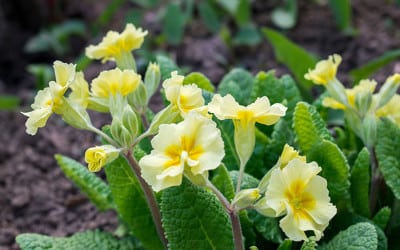These early spring blooms make wonderful colourful additions to pots, containers, and garden borders. Find out everything you need to know to successfully grow Primrose.
Plant Biography

What is the botanical name for Primrose?
Primula vulgaris
What are the common names for Primrose?
Primrose
Where is Primrose native to?
There are more than 450 different species of primula of which 5 are native to the UK. These are: Primula vulgaris, veris, elatior, scotica and farinosa.
What does it look like?
These long flowering, easy-to-grow-and-care-for perennials, provide a carpet of cheerful colour from late winter until late spring.
What colours does it come in?
Primulas can be found in a wide range of colours, yellow, mauve, pink, white and orange.




What growing conditions are best for Primrose?
Fertile soil that stays reliably moist but not waterlogged year round in sun or part shade.
Most primrose dislike dry soil but otherwise are generally unfussy.
How to grow Primrose
- Plant in spring 10cm-15cm deep and 15cm-30cm apart. Water in well and regularly until the plant has established, particularly during periods of drought.
- Hybrids benefit from a high potash liquid feed; the native species prefers leaf mould mulch which mimics its woodland origins.
- Regular deadheading will encourage more flowers. Cut back dead foliage in late autumn to encourage strong spring re-growth.
Do pollinators like Primrose?
The flowers of the native primrose, P. vulgaris, provide a welcome source of nectar and pollen in early spring for a wide range of pollinating insects.

Which Primrose variety should you grow?
Choose Primula vulgaris for a woodland or natural garden scheme. Drumstick primulas are ideally planted near streams and polyanthus primulas are for containers and mixed flower borders.
How big will it get?
There are many varied types of primula with heights ranging from 20cm up to 90cm.
How to plant Primrose successfully

Loosen congested roots and plant so the primrose’s base is at the same depth as the top of the soil. Use your hands to firm loose soil around the base of the plant.
How to care for it and keep it look good
Water newly planted primrose in well and regularly until established and during periods of drought.
Add a layer of mulch such as leaf mould or other well-rotted organic matter around the base of the plant. This helps to retain moisture around the plant’s roots.
How to propagate Primrose
Many primulas will readily self-seed if the spent flowers are left on the plant.
Alternatively divide the plant after flowering, separating plantlets that have formed around the main plant. Then plant them in the border where you want them to grow, watering in thoroughly.
How to problems can they have?
Primula can develop primula leaf spot, manifesting as yellow-orange areas or grey, papery tissue with holes appearing in those areas. Pick off affected leaves.
Varieties of Primrose to consider
There are many different related primrose plants including the native primrose, Primula vulgaris, auriculas, drumstick primula and polyanthus primulas.



When is the best time to buy Primrose?
Primrose and Primrose hybrids are often available in Garden Centres from late winter through to late spring.
Which garden styles are best for Primrose?
Naturalistic planting schemes for a wildflower meadow or cottage garden style are ideal for the native primrose. Hybrids also look good in a cottage garden design and mixed flower borders.


Leave A Comment